Physical Address
304 North Cardinal St.
Dorchester Center, MA 02124
The use of ultrasound to evaluate and guide treatment for injuries and medical conditions associated with sport and exercise; this may involve both clinical and in-the-field applications.
Evaluations are most often performed to answer a specific clinical question; need for further imaging and involvement of other medical imaging experts should be considered
Electric voltage from the base unit is converted to sound waves by the reverse piezoelectric effect. Sound waves are reflected at tissue boundaries, producing echoes. Sound wave echoes returning to the transducer are converted to volts via the piezoelectric effect, and these volts are assigned a gray-scale color and location on the screen to produce an image.
A medium is required for sound waves to pass through (acoustic coupling gel, water, etc.).
Degree of reflection dependent upon acoustic impedance ; similar acoustic impedance results in less reflection. Greater difference in acoustic impedance results in more reflection.
The angle at which a sound wave strikes a tissue interface is referred to as the angle of incidence. Perpendicular incidence refers to a sound wave traveling perpendicular to the boundary between two media; this maximizes the amount of echoes reflected back to the transducer and optimizes the image. Oblique incidence occurs when the sound wave is not traveling perpendicular to the boundary between two media and some echoes are reflected away from the transducer; this can result in the artifact of anisotropy (discussed later).
Short axis: Target structure (e.g., Achilles tendon) imaged in cross-section to the structure
Long axis: Target structure (e.g., Achilles tendon) imaged parallel to the structure lengthwise
Transverse: Anatomic region (e.g., knee) imaged in cross-section to the region
Longitudinal: Anatomic region (e.g., knee) imaged parallel to the region lengthwise
Anechoic: Black (i.e., no reflection)
Hypoechoic: Dark relative to the surrounding structures (i.e., less reflection)
Isoechoic: Same shade of gray as another structure
Hyperechoic: Bright relative to the surrounding structures (i.e., high reflection)
Higher frequency results in better resolution but lower penetration; recommended for imaging superficial structures
Lower frequency results in lower resolution but improved penetration; recommended for imaging deep structures
Linear array transducers: Flat transducer surface; sound waves exit perpendicular; minimizes anisotropy but produces a smaller field of view; recommended for superficial structures
Curvilinear array transducers: Transducer surface curved with sound waves exiting in fan shape; increases the risk of anisotropy but produces a larger field of view; recommended for imaging deep structures and guiding procedures at steep angles
Hypoechoic/anechoic region deep to the area of high reflectivity or high attenuation
Commonly deep to a bone or calcium (may also be seen deep to scar tissue or normal fibrous septae)
Refraction artifact secondary to velocity change deep to a curved interface
Helpful in identifying torn tendon edges
Can obscure imaging deep to edges of both normal and abnormal structures
Also referred to as increased through transmission
Hyperechoic region deep to an area of low attenuation
Commonly deep to fluid collections
Multiple internal reflections from highly reflective surface
Commonly seen with metal from needles or orthopedic hardware
Provides detailed evaluation of musculoskeletal structures and offers several advantages compared with other imaging modalities, including high-resolution imaging (submillimeter), ability to image in real time and interact with a patient during the examination, contralateral comparison examination, minimal metal artifacts, portable, relatively inexpensive, and no radiation or known contraindications.
Inherent limitations include limited field of view, limited penetration, incomplete evaluation of bones and joints, variability in equipment, and operator dependence.
Diagnostic musculoskeletal ultrasound examinations are either a complete assessment of a joint or anatomic region (e.g., anterior knee) or a focused, limited assessment of a specific structure (e.g., Achilles tendon). Complete examinations should include all relevant structures within the anatomic region, including muscles, tendons, joints, other soft tissue structures, and any identifiable abnormality. Although most joint regions are divided into quadrants, a complete examination of the shoulder should include all relevant structures.
High-frequency linear array transducer recommended
Exceptions are in certain deep tendons in patients with large body habitus (iliopsoas, gluteals, etc.)
Long axis (LAX): Fibrillar pattern of hyperechoic, tightly packed linear echoes
Short axis (SAX): Stippled clusters of dots resembling a “broom end”
Pathologic findings are similar across tendons. Location of injury within specific tendons will vary and often are affected by zones of relative hypovascularity, biomechanical factors, and repetitive trauma.
Tendinosis: Features include thickening/swelling of the tendon, hypoechogenicity, and heterogeneity with loss of usual fibrillar echotexture. In chronic cases, the tendon may appear atrophic instead of thickened. Intratendinous calcifications may be identified; power or color Doppler imaging may demonstrate intra/peritendinous hyperemia, termed neovascularity.
Tendon tear: Classified as partial, full thickness, and complete:
Partial-thickness tear: Well-defined focal defect in tendon confirmed in two planes; often seen as progression of tendinosis
Full-thickness tear: Tear extends across full thickness of the tendon (deep to superficial) but may not involve full width of tendon
Complete tear: Full thickness and full width of tendon; retraction of torn tendon fibers; this will appear as a gap within the tendon or complete nonvisualization of the tendon
Calcific tendinopathy: Calcium hydroxyapatite deposition within tendon; appearance is hyperechoic with variable amounts of posterior acoustic shadowing dependent upon type and phase of calcification; symptoms typically related to mass effect/impingement or inflammatory response in resorptive phase; may be asymptomatic
Tenosynovitis: Inflammation of tenosynovial lining of tendon sheath represented as complex fluid and hyperemic tissue adjacent to tendon within sheath; pain with transducer pressure helpful in distinguishing symptomatic tenosynovitis from other secondary causes of tendon sheath fluid (e.g., communicating joint fluid)
Anisotropy can mimic tendinosis or tear and is common, particularly in the rotator cuff; confirmation in two planes and careful scanning technique are critical.
Edge shadowing artifact can be useful in identifying torn tendon ends.
Dynamic imaging is helpful in identifying complete tears.
Clinical significance of neovascularity is controversial.
Rotator cuff tendinopathy and tears ( Fig. 64.2 )
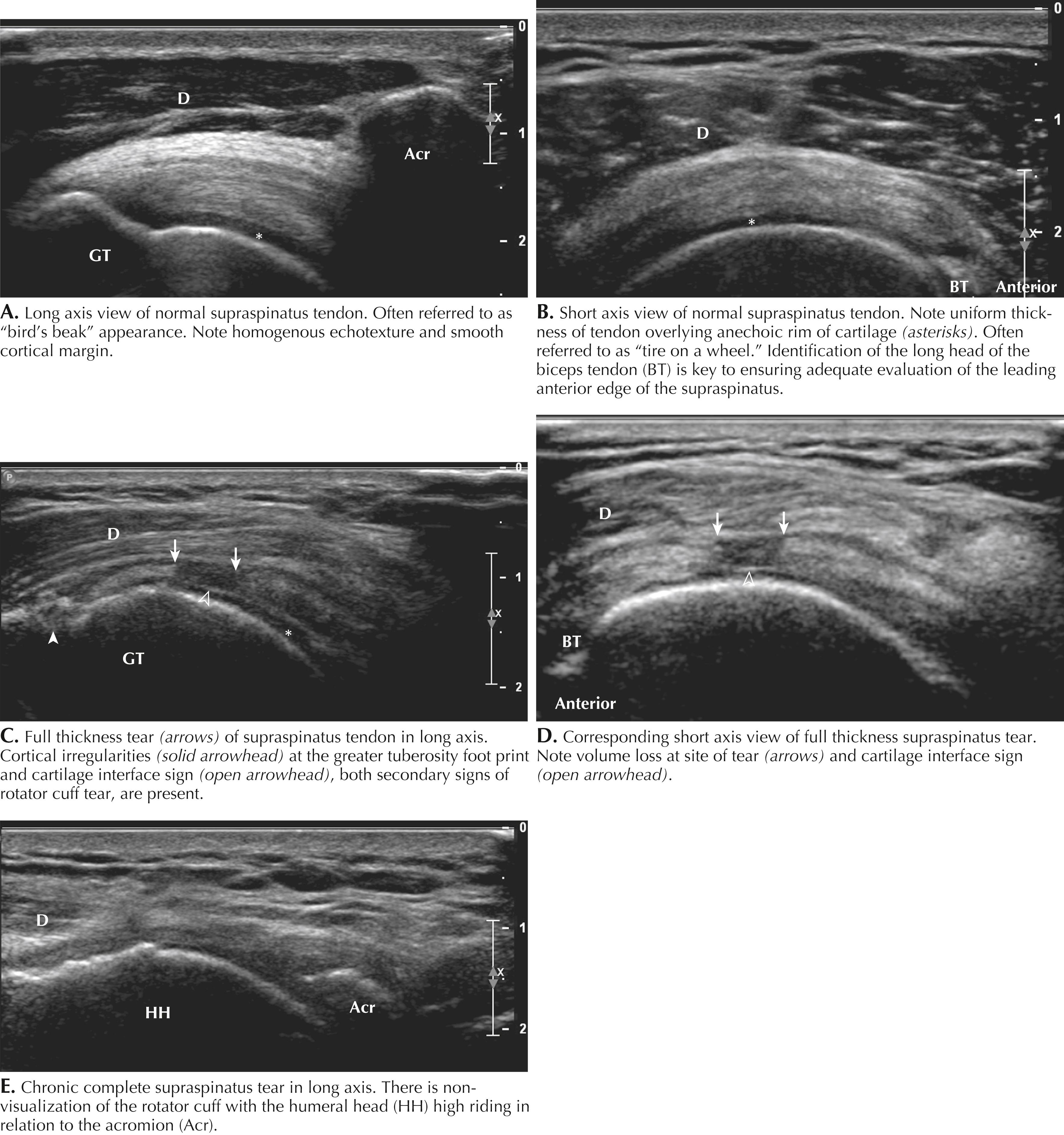
Proximal biceps tendinopathy ( Fig. 64.3 )
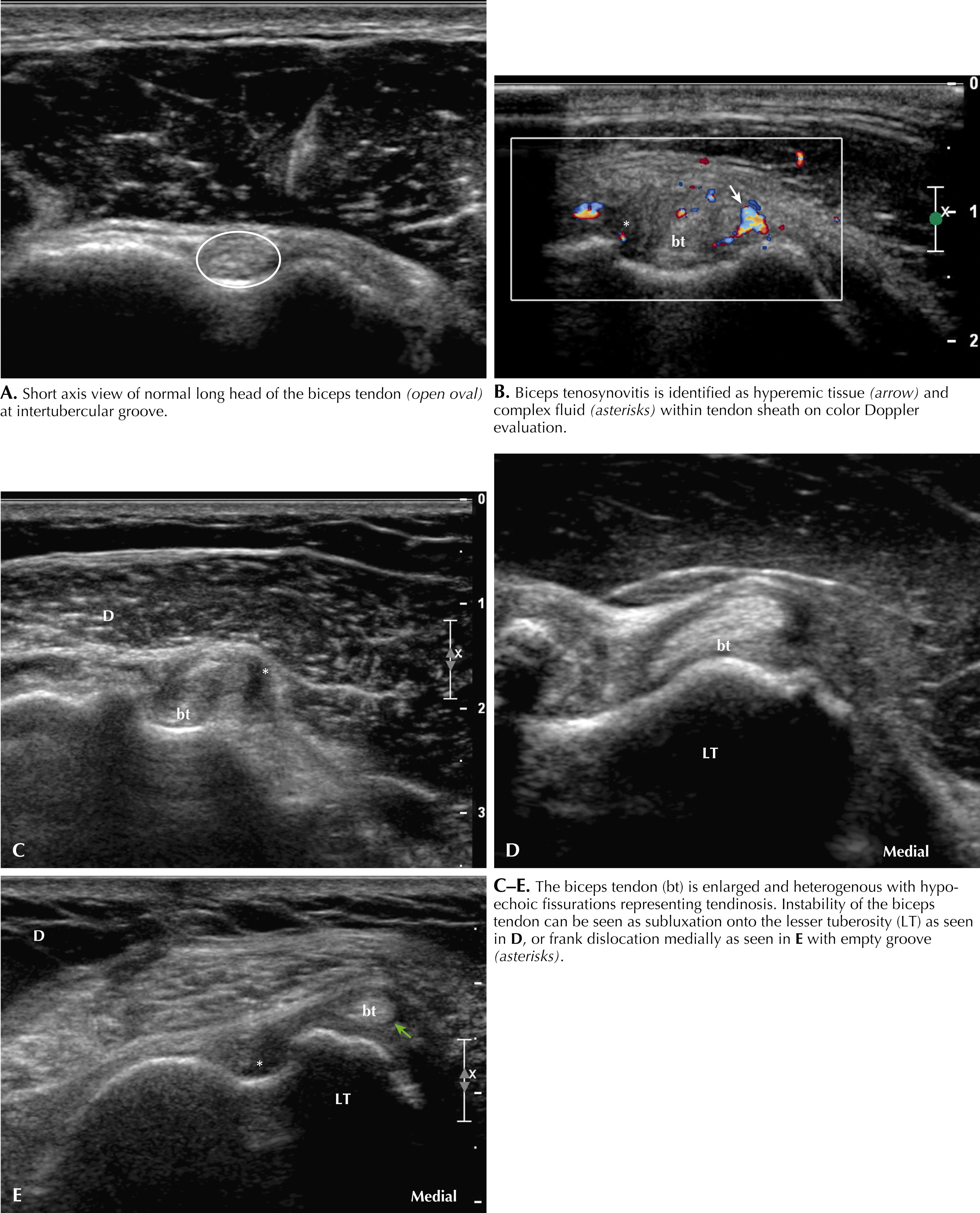
Common extensor tendinopathy ( Fig. 64.4 )

De Quervain tenosynovitis ( Fig. 64.5 )
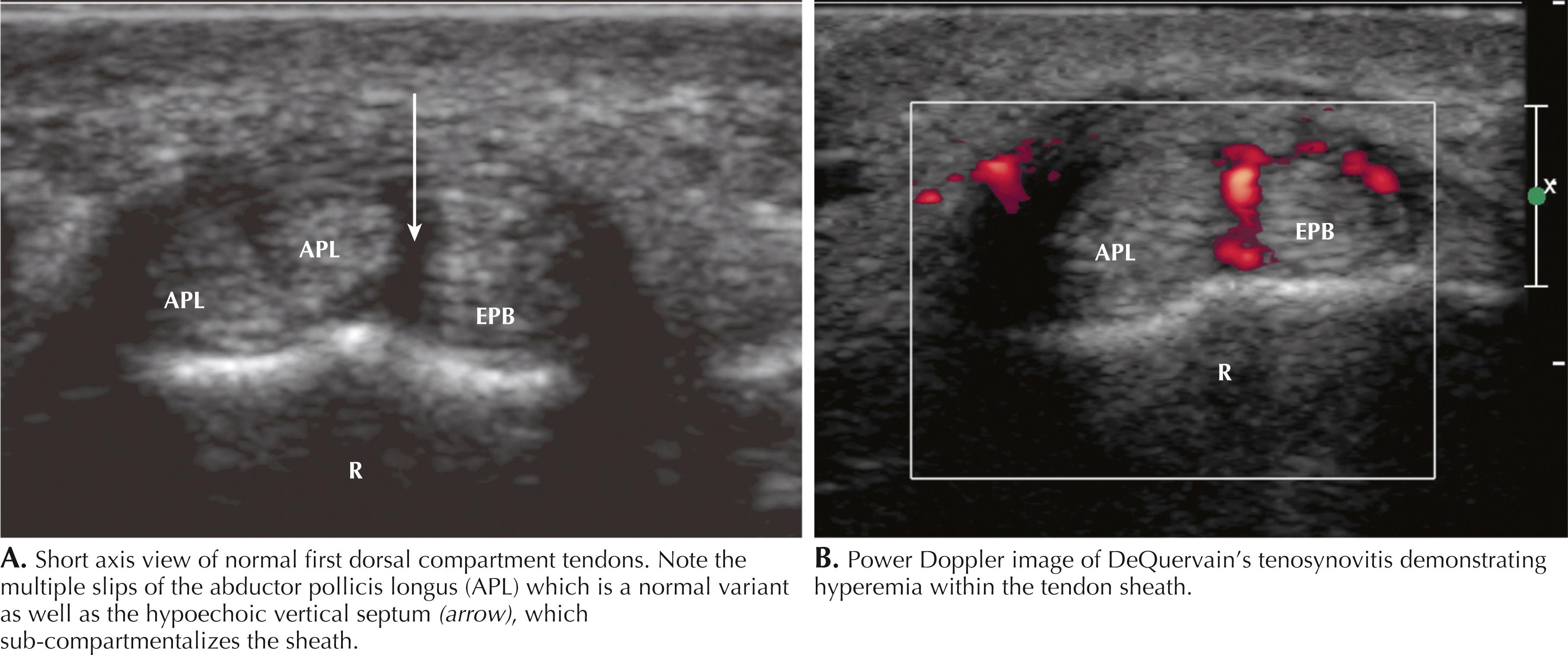
Gluteal tendinopathy ( Fig. 64.6 )
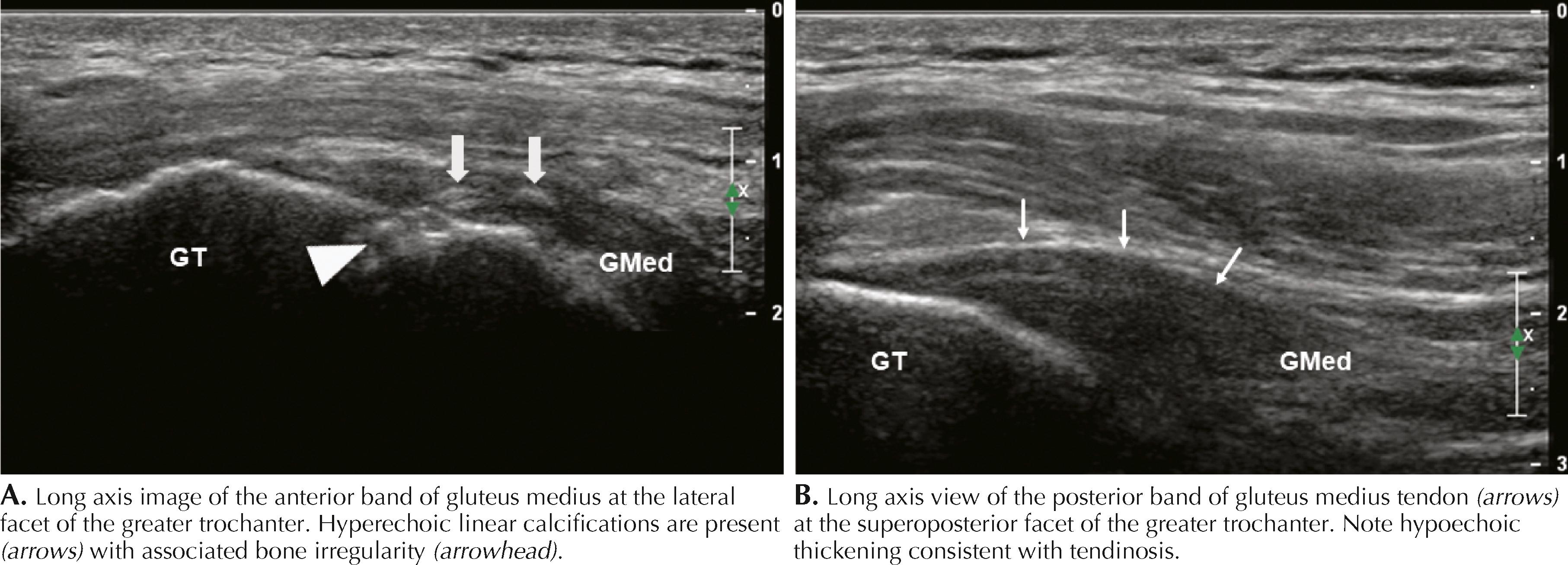
Proximal hamstring tendinopathy ( Fig. 64.7 )
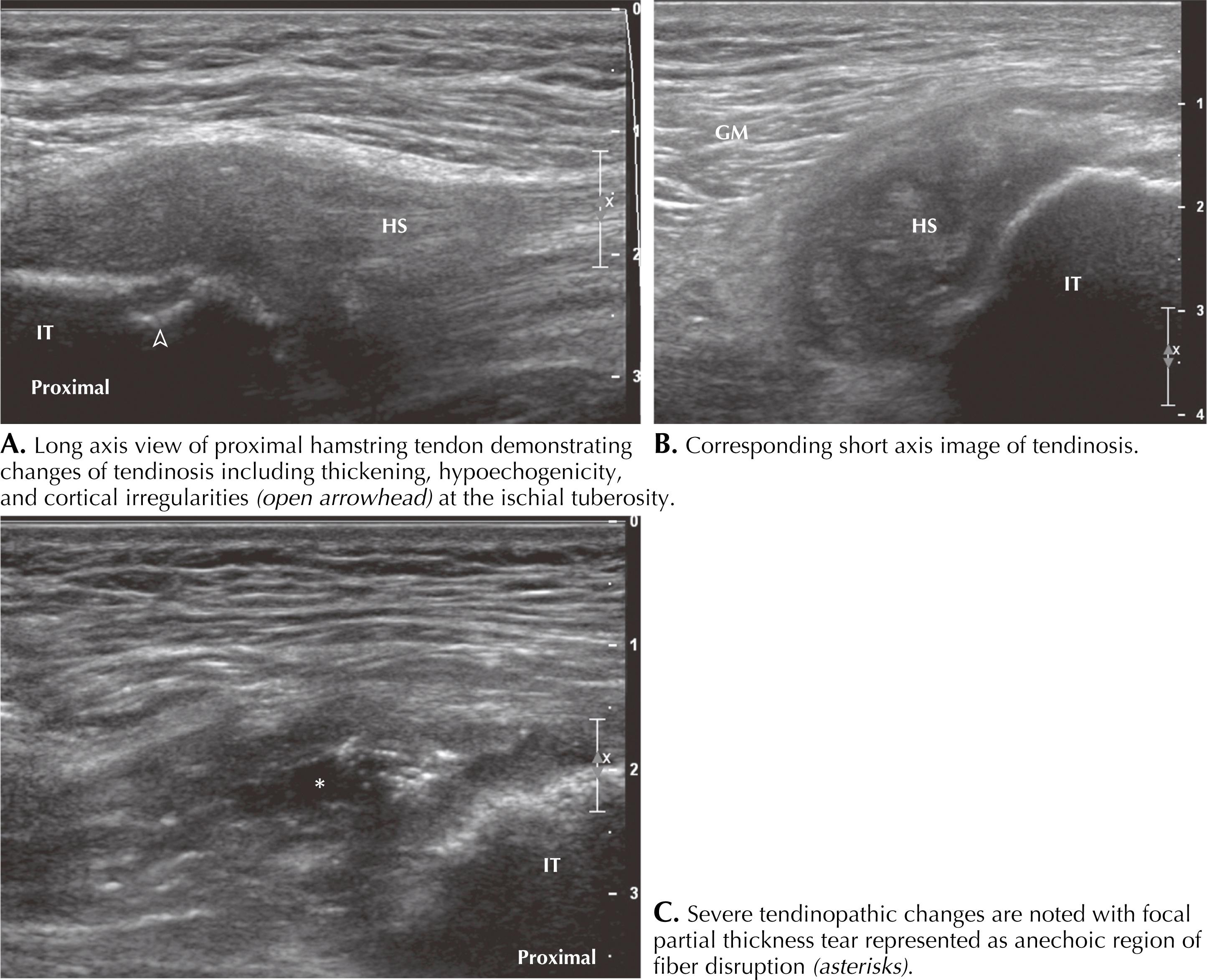
Patellar tendinopathy ( Fig. 64.8 )
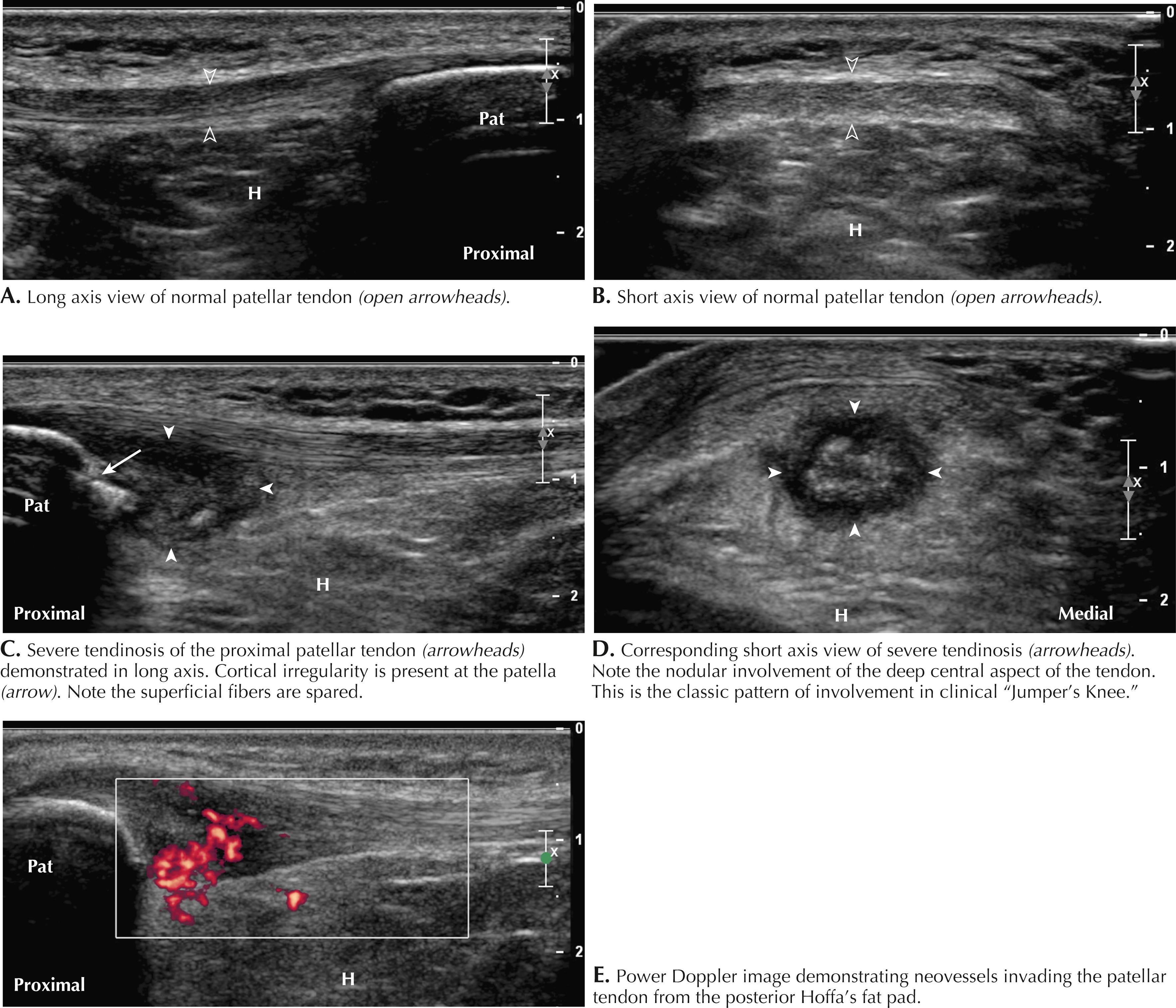
Fibular (peroneal) tendinopathy ( Fig. 64.9 )
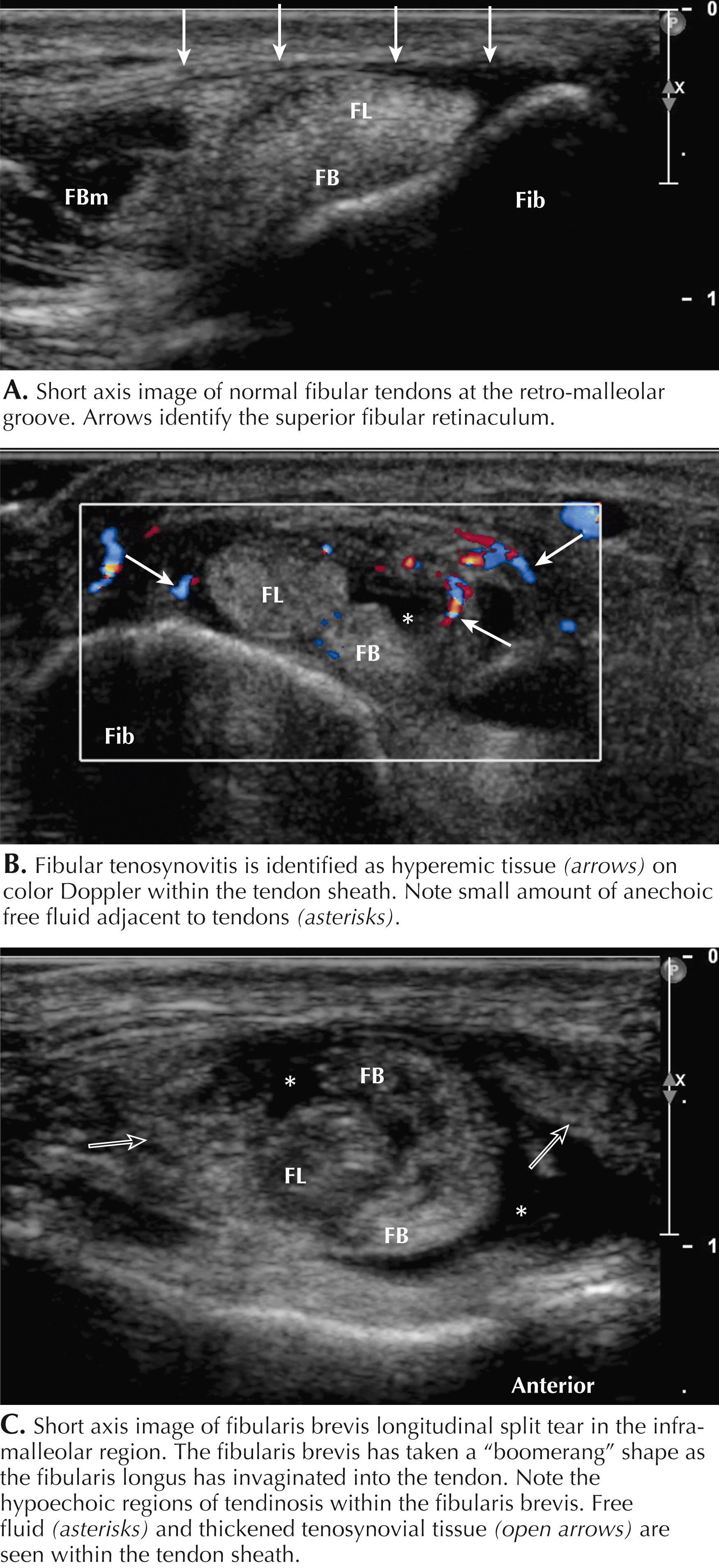
Achilles tendinopathy and tears ( Fig. 64.10 )
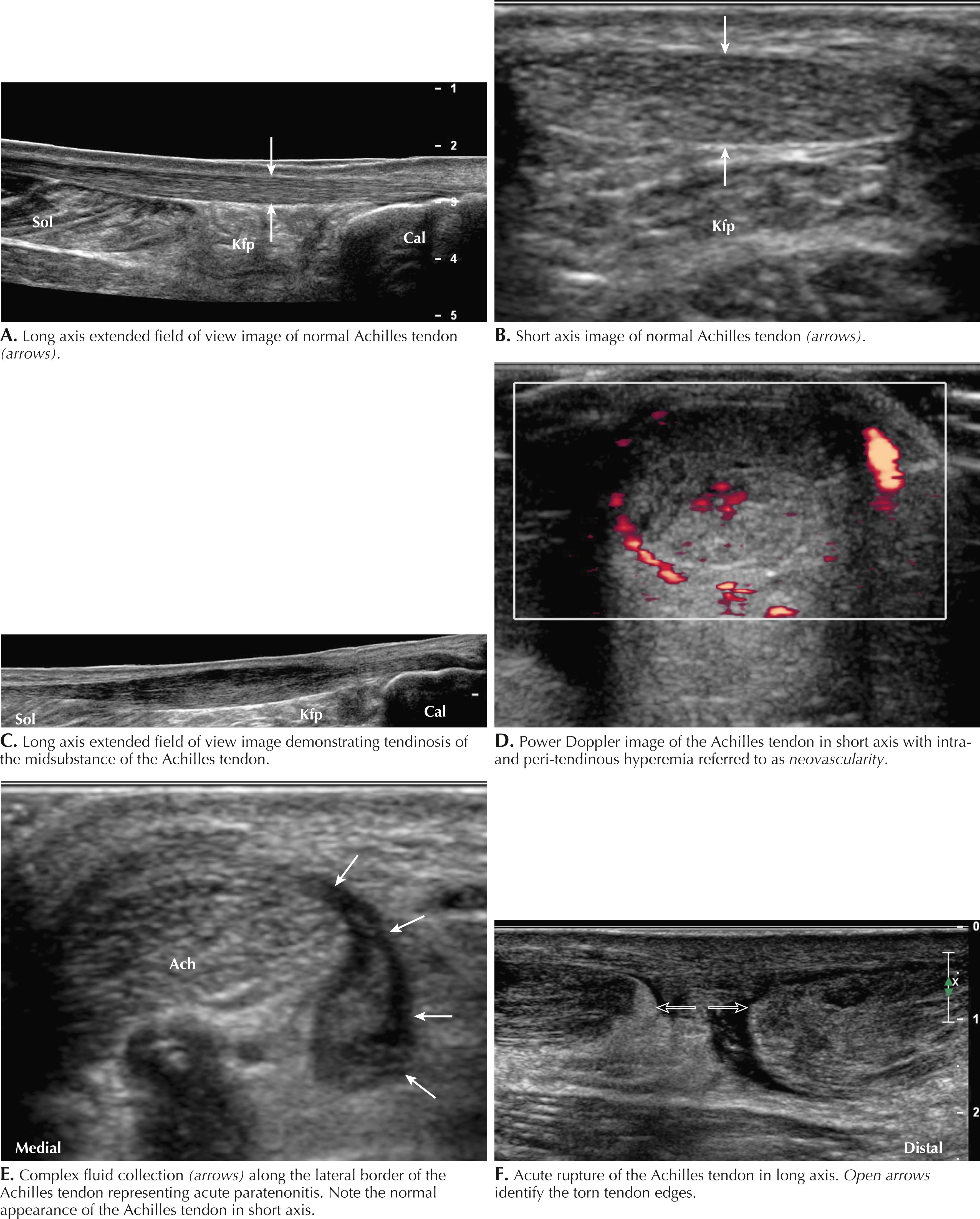
Plantar fasciopathy ( Fig. 64.11 )
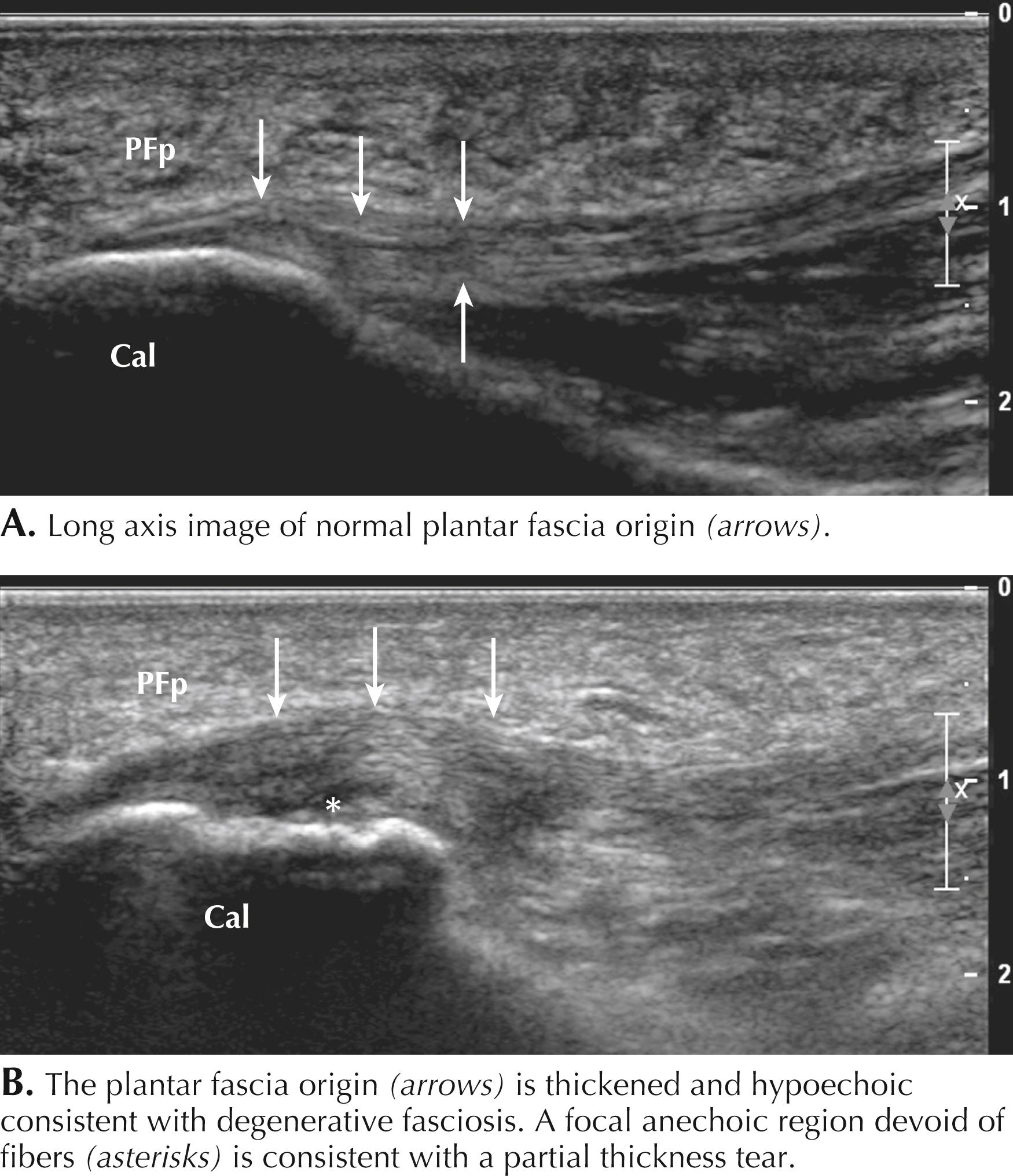
Hypoechoic muscle fibers/fascicles and hyperechoic septa of peri/epimysium form a pennate pattern on LAX and “starry night” pattern on SAX.
Strain: Focal disruption of normal fiber pattern/structure; in an acute injury, there will be swelling of muscle with possible focal defect in higher-grade injuries. If fibers are torn, hemorrhage may be identified as hypo/anechoic compressible fluid collection at the site of injury; will begin to organize into mixed echogenic hematoma and eventually form hyperechoic scar tissue. Hyperemia on power and color Doppler imaging is common in acute injury.
Hamstring muscle tear ( Fig. 64.12 )
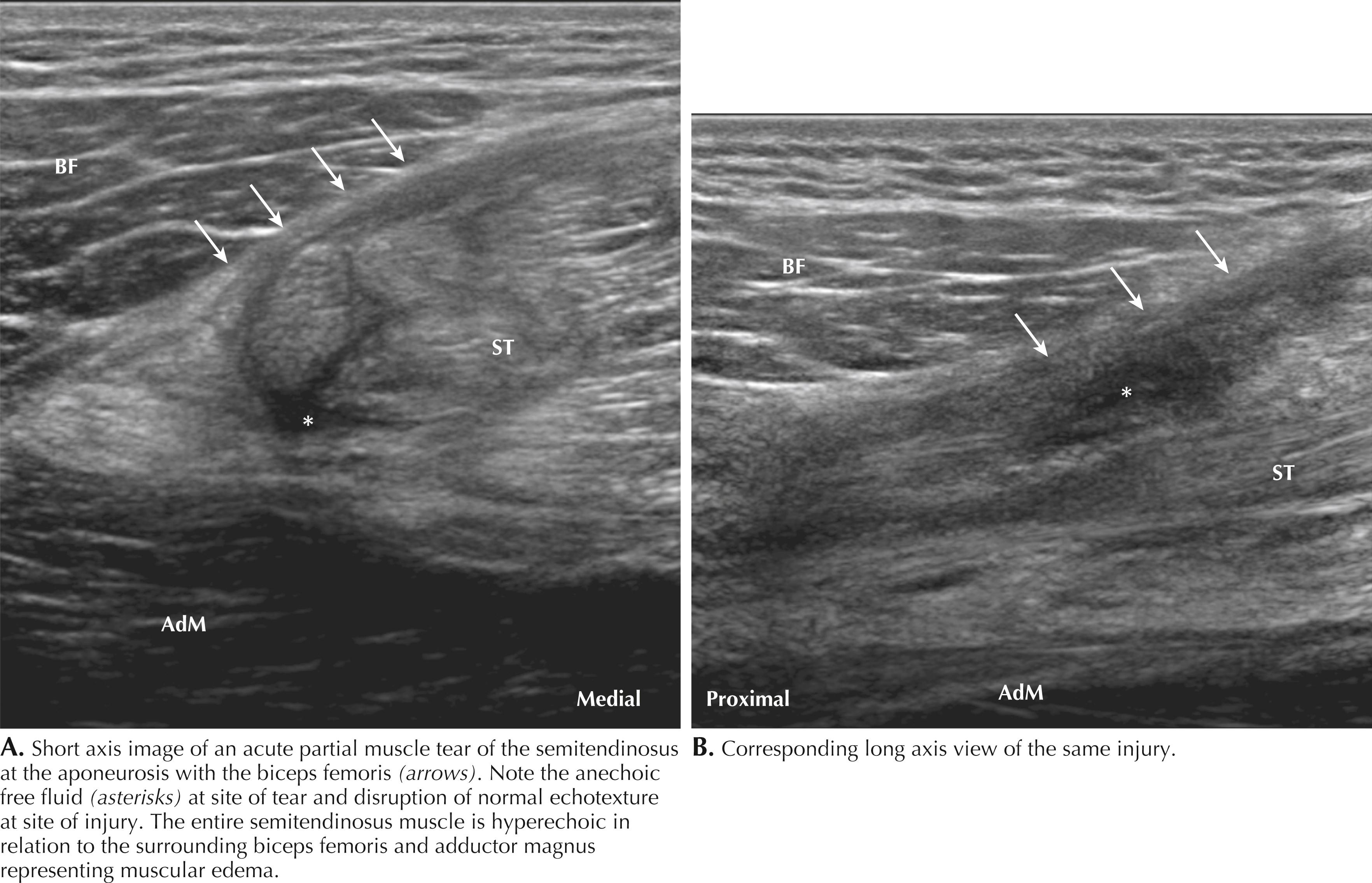
Medial gastrocnemius muscle tear ( Fig. 64.13 )

Contusion: Typically involves deep muscle fibers adjacent to bone (e.g., vastus intermedius in the thigh); myositis ossificans will appear as a hyperechoic, linear calcific density within the zone of muscle injury; demonstrated earlier on ultrasound than radiograph
Quadriceps contusion and myositis ossificans ( Fig. 64.14 )
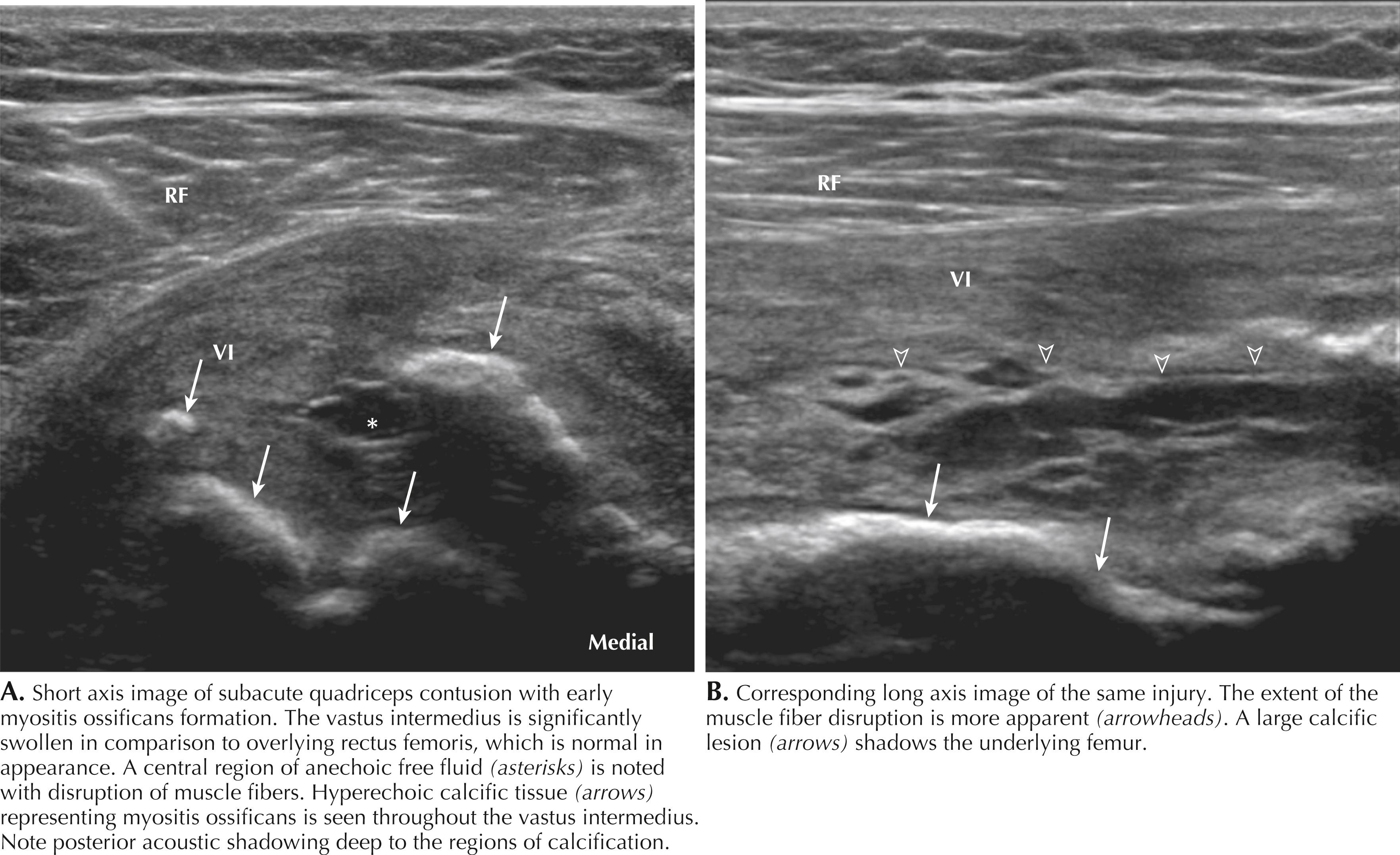
Identify bony landmarks and align transducer with ligament; LAX most useful imaging plane
Fibrillar echotexture pattern is less compact than tendon
Typically hyperechoic, but depending upon surrounding tissue, may appear hypoechoic
Become a Clinical Tree membership for Full access and enjoy Unlimited articles
If you are a member. Log in here